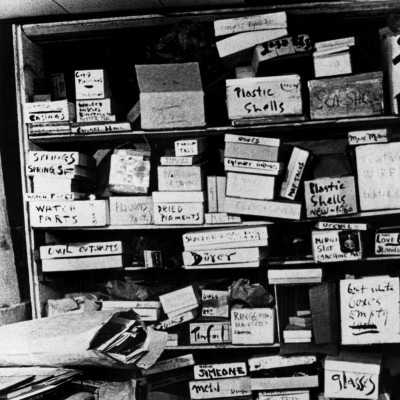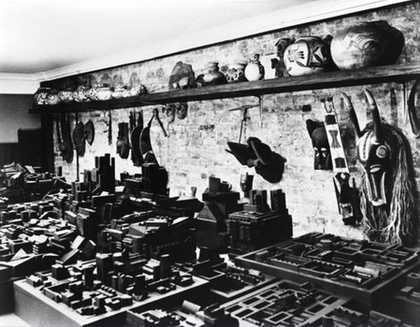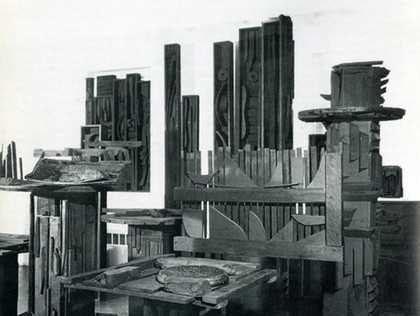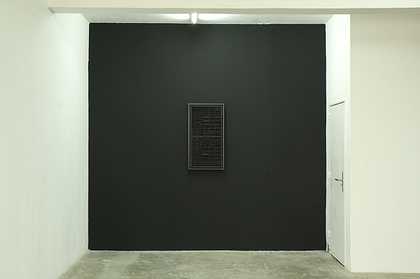Louise Nevelson once noted that ‘artists are born collectors’.1 The artist herself was a life-long collector and that pastime ultimately came to inform how she worked, culminating in her monumental ‘walls’, of which Black Wall (Tate T00514) is exemplary. Indeed, Black Wall, like many of Nevelson’s early walls, could even be said to enact the thematics of collecting, accumulating and storing, to the extent that it might be understood less as a taxonomic display than as a large assortment of things that have been gathered together to store or keep safe.
In the 1950s Nevelson was not alone in her impulse to collect, although perhaps the ways in which her sculpture alludes to that interest was prescient at the time. Today, the artist-as-collector is all the more common a phenomenon, one that spans a range of practices. Artists like Mark Dion and Damien Hirst have begun to straightforwardly transform their collecting habits into an aesthetic mode, leading to the production of artworks-as-collections.2 The topic even provided the focus for a 2015 exhibition titled Magnificent Obsessions: The Artist as Collector, held at the Barbican Art Gallery, which explored the history of the relationship between the hobby of collecting and professional aesthetic practices. That exhibition paired private collections with the original artwork of artists as diverse as Peter Blake, Pae White and Andy Warhol, positing that it has long been the case that personal collections have informed artistic practices in both form and content, probably as long as the hobby itself began to firmly take hold within mainstream culture.
Collecting became widespread in both the US and the UK at mid-century, so much so that it crossed the boundaries of avant-garde and popular culture. In the 1950s assemblage artists such as Robert Rauschenberg began frequenting surplus stores along Canal Street in New York and scavenged the streets for junk, while other artists, including Joseph Cornell and Nevelson, expanded the collecting practices they had begun as early as the 1930s, the period that saw the most rapid growth, standardisation and diversification of collections.
Collecting as a hobby
In the United States hobbies had been fast growing since the turn of the century, particularly in metropolitan areas like New York. The initial rise in the practice of collecting as a hobby corresponded directly to the nineteenth-century increase in manufactured goods, which ensured widespread availability and standardisation. For an activity to become a recognised hobby, many people had to be able to participate, and for collecting in particular, some agreement on the value of a collection had to be reached. As such, despite the fact that collecting as a practice emerged much earlier and focused more around unique and often natural objects, as historian Steven Gelber has suggested, ‘collecting came into its own in an industrial capitalist world’.’3 And what was initially a craze that began to emerge in the second half of the nineteenth century took hold all the more rampantly as a rise in leisure time emerged in tandem with the decrease in labour hours in the US in the early 1900s.
Able to be performed in one’s own time and within the home, hobbies provided obvious benefits. They were touted as ‘productive’ pastimes, said to offer various means of engagement that took one’s mind off work completely, but that nonetheless allowed the mind (and often the body) to remain active.4 A clear ‘outcome’ was seen to result from their undertaking, one considered to be satisfying and enriching. As an activity that could bridge the realms of work and play, collecting became idealised as a hobby, while effectively exposing the tension at the heart of many leisure-based activities that seemed all too much like substitute forms of professional labour.
The Depression era was also responsible for changes to the rhetoric of hobbies in ways that increasingly closed the gap with work. It was all the more common, for instance, for hobby lobbyists to note that a hobby was in fact ‘a job you can’t lose’. This line was joined with those that linked idle hours to crime and degradation, such that hobbies, it was argued, were an antidote to all. In that they taught ‘the rewards of hard work and the value of neatness’, helped to ‘develop special knowledge’, and prevented ‘mischief’, hobbies were activities performed in one’s own time that aligned fully with ‘socially sanctioned values’.5
Collecting, like other hobbies, had its own set of rules that were followed by all true collectors, as well as a hierarchy that distinguished good collections from bad. Beyond the key requirement of settling upon the correct type of collection – one that perhaps was undervalued but ripe for appreciation – classification and categorisation were two principal components of a collection, responsible for securing its clear, systematic order, and thus its proper status. This was partly a way of imparting a degree of science to the activity, to combat any pejorative associations with the amateur that clung to terms like hobbyist and hoarder.6 By cataloguing and classifying, the collection could thereby be seen to yield the knowledge and understanding conventionally associated with taxonomic systems, which order, rank, and define.
Nevelson, Cornell, and the artist-collector
In the 1940s and 1950s convention held that there were rigid parameters bounding the types of collecting and the manner in which it could be conducted as a personal hobby. There is, for instance, a key distinction between tangible collections, which mimic the real economy (think baseball cards or stamps), from those that do not (life-lists made by birdwatchers, for example).7 Artists like Cornell and Nevelson, who collected widely, produced tangible collections yet operated in ways that were more akin to the collector of intangible things. They each put together ad hoc categories in place of conventional systems of classification, and as a result collected in ways that disregarded the usual values ascribed by a real economy. Cornell collected pipes, sherry glasses, marbles, postcards, books and ephemera, and he spent massive amounts of time classifying and cataloguing his collections. But the results were housed in files and shoeboxes rather than proper display cases, a storage system that amounted to a sort of ‘laboratory’, as he saw it, for exploration and inspiration (fig.1).8 As a practice, this approach departed freely from the conventional organisational procedures of the hobbyist.

Fig.1
Cornell’s basement studio, 3708 Utopia Parkway, Flushing, New York 1964
Collection of Duff Murphy and Janice Miyahira
© Terry Schutté

Fig.2
Nevelson’s Spring Street home, New York, c.1963
© Louise Nevelson
Nevelson collected somewhat more narrowly. While she first sought out wooden items abandoned in the street — furniture parts, crates, old toys, posts and architectural fragments — as the 1960s progressed into the 1970s Nevelson began ordering various sculptural elements rather than waiting until she happened upon preferred sizes and shapes. Other objects of choice were strewn around the artist’s studio and apartments as well. One visitor to her Spring Street studio (fig.2) described opening cupboards to reveal ‘a hoard of oddments and tchotchkes: vanity sets, inlaid boxes, tarnished trays, ugly Edwardian candlesticks with silver frills, like the stock of a dotty junkshop owner who cannot bear to part with anything’.9 This begins to approach the quasi-hobby of ‘junk snupping’, a casual term which began to circulate in the 1920s that referred to the collecting of old commonplace items.10 The antique shops that once lined Second and Third Avenue in New York – not far from her studio in the 1950s – are known to have been haunts of the artist.11 But even in the case of Nevelson, there was a kind of instinctual impulsiveness that governed her choice of items for personal use and display that had little to do with established parameters.
Nevelson could not even rightly be said to have specialised in antiques since her primary interest was in castaways. And while she also collected Native American and African masks and pottery, early American paintings and other Mesoamerican artefacts that could be construed collectively as ‘primitive’, none of these constituted proper items to collect by the 1940s. There was rarely, if ever, a guiding principle or epistemic framework that governed either her collecting habits or her organisation of the objects afterwards.12 Instead, she tended to simply fill rooms in her home with her acquisitions.
What this points to is the way in which Nevelson, and Cornell too, embraced the avidness and enthusiasm of the hobbyist without conforming to the established idea of the collector as someone who accumulates objects ‘in a particular systematic way that necessitates the development of specialized knowledge’.13 If specialised knowledge was brought to bear on their collections – and it is hard to see what that would be – Cornell and Nevelson did not showcase it. Their means of collecting was always made to appear haphazard and based on whimsy rather than any external measures of value, knowledge or completeness.
Excess and order
Rather than utilising the common curio cabinet of the collector, or the basement shoe box storage methods of Cornell, Nevelson mixed storage and display within her home, a practice that had a significant impact on her work.14 Her ‘walls’, which, as legend goes, relate directly to her habit of piling spare parts for assembly along the floor in crates and other boxes, are the most well-known examples of her tendency to blend these two considerations of the collector. Indeed, directed acts of storage were combined seamlessly with the display of other objects that hung on walls and sat on shelves around the room, such that, as can be seen with Black Wall, the two were pointedly conflated and confused within the space of her home.
The casual way that Nevelson amassed wooden items was matched by the unconventionality of her domestic methods of display. Rather than producing a carefully constructed space using principles of interior design, the rooms of her home were often overfilled to the extent that it was difficult to distinguish between what was functional and what was decorative. Her tendency to overcrowd reputedly led to Nevelson’s routine need to empty out or purge the space. Describing her home in 1958, Time magazine reported that because ‘her house began to feel crowded not long ago, she put all her furniture out onto the sidewalk, keeping only a couch, a table and three chairs’.15 Critic Hilton Kramer has confirmed the account: ‘Its interior seemed to have been stripped of everything, not only furniture, rugs, and the common comforts of daily living, but of many mundane necessities.’16 According to Jean Lipman, herself a collector of Nevelson’s work, these alternating acts of accumulation and emptying persisted throughout her life.17 That Nevelson routinely discarded, dissembled or otherwise relinquished her collections constitutes an unusual attitude toward a life-long hobby, one that matched the kind of whimsical attitude with which she pursued it to begin with.
What comes to the fore in descriptions of the collecting methods of artists like Cornell and Nevelson are the ways they imparted a kind of privacy to their practices that seemed to detach them from conventional collecting activities. Indeed, this approach increasingly stood apart from the commercialised hobby culture of the 1950s. As Gelber suggests:
[commercialisation] may have made hobbies less pure in some sense by openly tying them to the marketplace, but hobbies had always traveled on a track parallel to work. The postwar environment gave participants the option to acknowledge the deeper meaning of productive leisure by making amateurs more of a mass market and making the products of leisure more obvious commodities.18
In contrast to this tendency, artists at the time began to assert the possible connections that hobbies, as a kind of personalised labour, might have to freedom, intimacy, imagination, and tactility over and above any sort of marketable outcome.19 In a section of The Arcades Project entitled ‘The Collector’, Walter Benjamin asserts something of the power of collecting by pointing to the way in which it undoes the traditional course of events. Where the manufactured object, like the harvested crop, is made to be dispersed and consumed, the act of collecting works against this tide, curbing the call of function in favour of a sort of ‘completeness’. Benjamin writes:
[I]t is a grand attempt to overcome the wholly irrational character of the object’s mere presence at hand through its integration into a new, expressly devised historical system: the collection … It is the deepest enchantment of the collector to enclose the particular item within a magic circle, where, as a last shudder runs through it (the shudder of being acquired), it turns to stone.20
In one sense, Black Wall can easily be seen as a display case of discarded trophies, castaways that have lost their use value and now derive a new value from their accumulation. Following Benjamin, however, these collected objects, detached from their original function, might also amount to a new type of completeness, a kind of encyclopaedic history of wood in its various states of manufactured being.21 Or at least this idea springs to mind, if only to be swiftly undercut by the means with which Nevelson obscured and obviated any easy classificatory system that might have been suggested by the work’s gridded structure. Black Wall can only be apprehended as a ‘collection’ abstractly, in part because of the monochrome black paint, but also because placement within individual crates is often repetitive, redundant even, and overdone as well, so that there is no adequate space left for ‘display’. Without this, the work’s status and ultimate function as a collection is undermined.
The failure to provide adequate space for ‘display’, a hallmark of the more randomly arranged walls of the 1950s, appears to issue from the casualness of Nevelson’s method of collecting. She was known to pick up discarded wooden fragments found on the street or in some other abandoned state, and on occasion enlisted friends, with whom she walked through the city, to help her collect bed frames and headboards, or other used parts that might otherwise have gone to waste. As a result, many of her first walls have a bric-a-brac feel about them. As one critic of the early work noted: ‘Conglomerations of wooden blocks may suggest barrels in a yard, the paraphernalia of a diary or a kitchen, at a remove from actuality, as vividly and solidly as her nests of boxes suggest dedication to some unguessable hobby.’22 Similarly, Hilton Kramer observed in 1958 that while her contemporaries ‘err on the side of frugality and emptiness, she has moved swiftly into a kind of gluttony of images’.23
While Kramer correctly evokes the feeling of excess upon encountering Black Wall, to suggest that ‘images’ emerge is not quite accurate. Instead the sculpture showcases variation and apparent (carefully arranged) haphazardness.24 For example, the variation in the size and orientation of the boxes — with the smallest box nestled near the centre to fill a gaping hole left by the surrounding oversized crates – thwarts any sense of classificatory clarity. Similarly, each stacked crate contains different wooden fragments, juxtaposed in ways that seem to show off the similarities and differences between them: rough and refined, large and small, rounded and dagger-like, manufactured and natural. The irregularity of the boxes and their contents, as well as the provisional feel of the accumulation, appears to deny the application of any organisational logic. In fact, a sort of contest seems to be played out in many of the most cluttered crates, as though the fragments are trying to resist the threat of order. What comes to the fore here is the way in which the accumulation of materials and organic overgrowth feels as if it is itself responsible for the multiplication and mutation of the boxes. By refusing to conform to the status of ‘display’, Black Wall asserts itself as an embodiment of the act of collecting, rather than the image of a collection.
The tactility of the collector
Nevelson encouraged this understanding of accumulation as an act within her early gallery installations, such as her 1958 exhibition Moon Garden Plus One at Grand Central Moderns in New York (fig.3). This installation was made to look environmental, comprising multiple works in concert with one another to create a closed-in, intimate, almost cave-like atmosphere. Here again, the installation amounted to more than the image-oriented visual profusion observed by Kramer. The overall effect, as with much of the work itself, was tactile rather than optical, accentuated by the decision to block out windows, dim lights, and replace existing lights with a spare number of luminous blue bulbs. An interest in tactility, Benjamin proposed, is characteristic of the collector: ‘Possession and having are allied with the tactile, and stand in certain opposition to the optical. Collectors are beings with tactile instincts.’25 Nevelson might be seen to have built this sensibility into her walls and environments, which act to assert the value of the tactile.

Fig.3
Louise Nevelson, Moon Garden Plus One, exhibition at the Grand Central Moderns gallery, New York, January 1958
© Louise Nevelson/DACS, 2016
Although the boxes Nevelson used in her walls are usually described as crates, several of the containers in Black Wall have the kind of dovetail joints that indicate they may have originated as drawers, a detail that points to the way the work retains the feel of a vessel for storage, for close touch, proximity, and even secrecy. In one box, for instance, the chiselled-out hole once occupied by the lock mechanism of a drawer is readily visible. The sides of the same drawer retain thin routed grooves, which would have held movable dividers by which its contents would have been compartmentalised. Such details represent yet another way in which Nevelson’s materials, despite and because of their extensive fragmentation and reorientation, retain the tactile as well as visual pleasures of their prior lives: wooden turnings arouse the sensation of grasping a chair, for example, or running one’s hand across a balustrade.
Moreover, the stacked quality of Black Wall — the boxes are pieced together, piled, balanced haphazardly, flipped on their sides, and in some cases turned sideways — only serves to make the physical act of creation even more palpable. Again, the poles of display and storage appear to have sprung from one and the same action. The sensation is peculiar, particularly when contextualised in relation to the experiential and often performative art of the late 1950s and early 1960s, exemplified by Allan Kaprow’s happenings. In the case of Black Wall the ‘event’ is replaced with its component parts, housed in a way that brings out the domestic ordinariness of its making. This is not a closet or a cupboard exactly, but it is not entirely dissimilar either. The lack of straightforward organisation or classification lends the work the feeling of having been brought together over time, as if a series of minor moments led to the creation of this somewhat grand amalgam.

Fig.4
Louise Nevelson
Open Zag III 1974
© Louise Nevelson
The significance of these associations become all the more pronounced when a work like Black Wall is compared to Nevelson’s relief sculptures from the 1970s, such as Open Zag III 1974 (fig.4), made of similar materials and also painted a uniform black. Both consist of an amalgamation of wooden fragments, but their manner of display differs: in the reliefs, the sense of construction and composition replaces the sense of containment that the crates provide in the wall. That vivid tactility of Black Wall yields in the later work to an optical sensation of materialised brushstrokes mixed with a sense of textured form of the kind found, for instance, in the surrealist frottage of Max Ernst. The reliefs, it could be said, take on the feel of drawings as much as they do of sculptures. In contrast, Black Wall feels less intentional, less thoughtful, but also seems to be the product of a long, slow period of time. Its wooden fragments, nearly all of which formed part of domestic objects, no longer seem connected to their original function; instead they seem to simply assert their status as kept, preserved, or contained.
Such thoughts lead back to the nature of the ‘collection’ that comprises Black Wall. Are we to think of Nevelson as the inveterate collector, always on the hunt? Furthermore, given the strong tactility of the collection, the contained and the preserved, does Black Wall properly represent what is often seen as the possession obsession understood by Marx to be the vice of the collector?26 Because Nevelson enacted the thematics of collecting, rather than presenting an ossified collection, Black Wall not only resists these associations but arguably engages with the organic side of accumulation, manifesting the invisible ways in which the daily and the domestic amass over time.
Unlike the hobbyist, who thinks of collecting as a pastime, one that can edify, ennoble, or otherwise promote value, Nevelson’s Black Wall should be thought of less as the manifestation of a pastime than of the daily accumulation of materials, perhaps even with an exaggerated hand, so that it becomes at once overly visible (showy, excessive) and yet hard to see (stored, housed, kept for later). This performance of collecting might in turn be what inspires the sensate experience of her work, the quality of which has been remarked upon countless times since she first began to exhibit her environments. By engaging the body of the viewer as much as it does the eye, Black Wall fails to perform the sensory alienation that accompanies possession obsession — and all of the commercialised implications of the hobby of collecting that it conventionally represents — and thus confirms its status as an improper collection.
